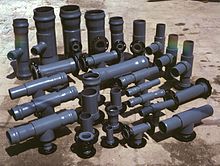


A fitting or adapter is used in pipe systems to connect sections of pipe (designated by nominal size, with greater tolerances of variance) or tube (designated by actual size, with lower tolerance for variance), adapt to different sizes or shapes, and for other purposes such as regulating (or measuring) fluid flow.[1][2] These fittings are used in plumbing to manipulate the conveyance of fluids such as water for potatory, irrigational, sanitary, and refrigerative purposes, gas, petroleum, liquid waste, or any other liquid or gaseous substances required in domestic or commercial environments, within a system of pipes or tubes, connected by various methods, as dictated by the material of which these are made, the material being conveyed, and the particular environmental context in which they will be used, such as soldering, mortaring, caulking, plastic welding, welding, friction fittings, threaded fittings, and compression fittings.
Fittings allow multiple pipes to be connected to cover longer distances, increase or decrease the size of the pipe or tube, or extend a network by branching, and make possible more complex systems than could be achieved with only individual pipes. Valves are specialized fittings that permit regulating the flow of fluid within a plumbing system.
- ^ "Glossary". Plumbing Manufacturers International (PMI). Retrieved 2024-01-01.
- ^ "Plumbing Glossary". PlumbingMart. Archived from the original on 2022-03-31. Retrieved 2 July 2019.